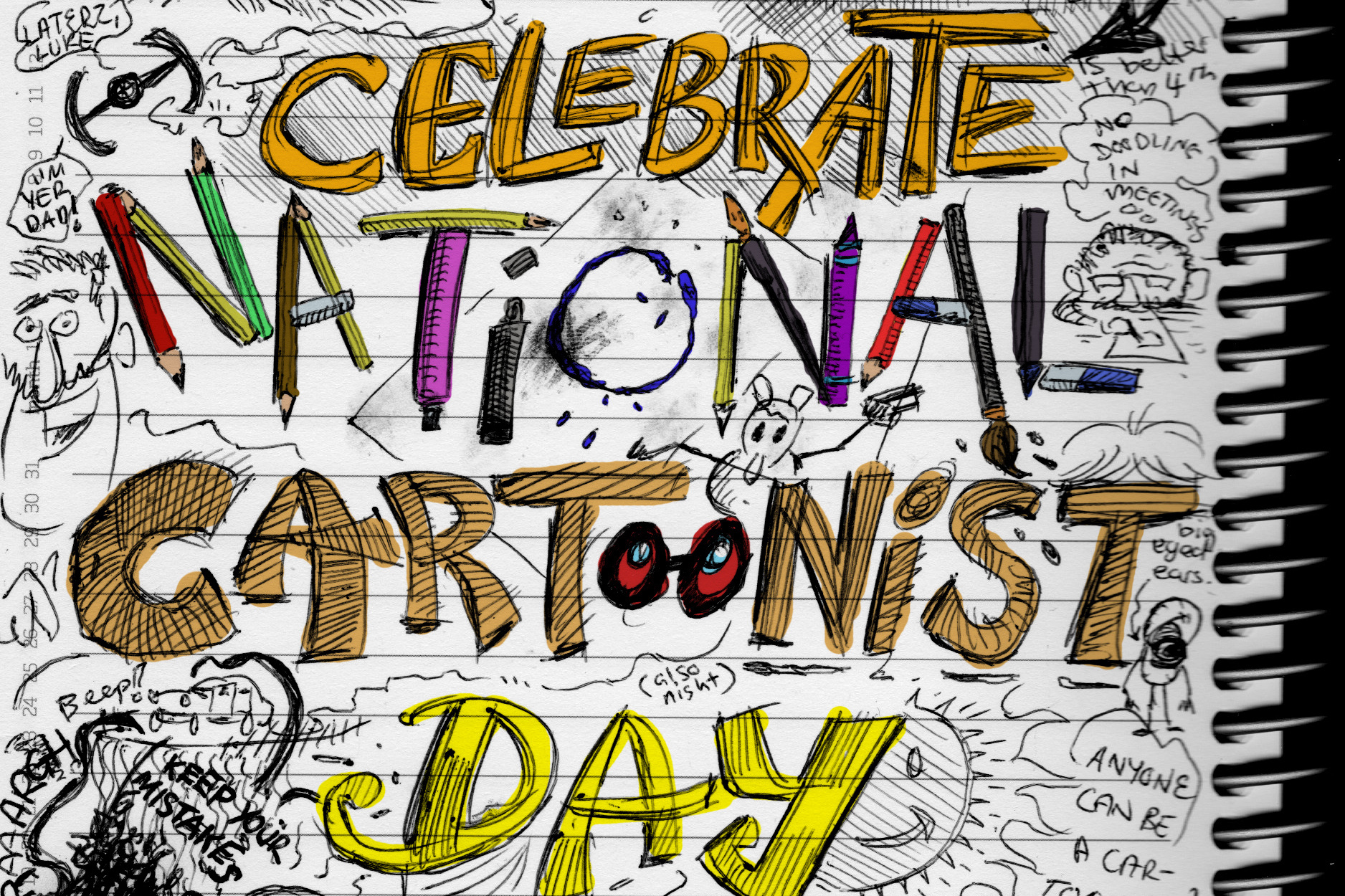What is National Cartoonist Day?
Since 1999, National Cartoonist Day has celebrated the the impact of cartoonists past and present and the effects of the cartooning industry on society and in popular culture.
When is it?
Today! May 5th. The day after Star Wars Day.
Why May 5th?
The National Cartoonist Society chose this day to coincide with the first appearance (in colour) of the once uber-famous cartoon character ‘The Yellow Kid’, created by cartoonist Richard F. Outcault. The Yellow Kid first appeared in a cartoon strip titled ‘At the Circus in Hogan’s Alley’ on May 5, 1895, in the now-defunct New York World newspaper.
Who he?
The Yellow Kid was a slum alley urchin who gets into all kinds of slapstick hijinks. He had a distinctive shaved head (lice was a real problem for the impoverished at the time) and wore a voluminous hand-me-down nightshirt that sported ever-changing slogans in a satire of advertising billboard messaging. The strip was humorous social commentary designed to raise awareness in wealthy newsreaders to the plight of the poor at the time.
Popular, was he?
The Yellow Kid was a cartoon character so mighty that his appearance in the pages could sell tens of thousands of newspapers, and he quickly became a merchandising success and advertising icon. Some call him the world’s first commercially successful comic strip character.
Unfortunately, Outcault didn’t secure the rights to the character, and when he changed employers, it led to the unusual situation of two newspapers publishing competing Yellow Kid stories simultaneously.
Why is The Yellow Kid so important?
The Yellow Kid wasn‘t the first ever comic but it did lay the foundation and develop what we now consider basics in comics language, especially through the use of speech bubbles and recurring characters.
Do I need to remember all that to do a cartoon?
No. It’s just a bit of an origin story. Cartoons and comics love origin stories, just ask Peter Parker and Bruce Wayne.
I would be a cartoonist but I can’t draw!
You’ll be pleased to know you can draw. And you get better by doing it (let’s not call it practice and make it sound like work).
Maybe it’s stick figures and speech balloons now, but soon it could be much improved stick figures and speech balloons with better calligraphy. Or maybe you’ll become very accomplished. Who knows?
Anyone can cartoon. It’s built into us. Colourful galleries of kids’ cartoons adorn fridge doors in millions of households worldwide. Check your notes from your boring work meetings – they’re probably 50% doodles. Don’t remember doing them? Your subconscious creative side took over.
No matter your age or artistic ability, cartooning is an easy and natural way to express yourself.
What do I use to cartoon with?
Cave people used to scrawl their hunting stories on the cave wall using natural pigments (simultaneously creating cartooning, interior decorating and graffiti).
These days you can use a pencil, fineliner, felt-tip, ballpoint, technical pen, nib or brush and ink, brush pen, jumbo marker, crayon, charcoal, computer, paint, collage ¬– a mix of any or all and other things not mentioned here.
What paper do I need?
None, if you’re going digital. But really, you can cartoon on anything; drawing pad, writing pad, moleskin notebook, loose leaf printer paper, sticky note, watercolour paper, smooth vellum, back of an envelope, or drawing tablet.
There are many ways for you to complete your cartoon ideas, don’t be overwhelmed. Trust your instincts and find what works comfortably for you.
Uh-oh. I haven’t got an idea.
Nothing (except spiders) is more terrifying/exhilarating than a blank page.
Remember, a cartoon can be in any style about anything – that’s a lot of leeway for creativity.
However, sometimes initial ideas do still dry up like puddle in a Saskatchewan summer. If that happens, why not take a refreshing dip into the stream of consciousness and see where the flow takes you. Draw the first thought in your head, read a headline, choose a random word, or draw what you see directly in front of you.
Your cartoon could be a mundane office conversation everyone can relate to or make absolutely no sense to anyone and feature a weird, nameless creature that despite being hideous is probably friendly to kids. Or not.
You could draw a wordless cartoon adventure or have so many speech balloons the page is in danger of floating away.
Informing, questioning, entertaining - cartoons can accomplish much with just a few lines. Just start to draw and see what happens.
What size is a cartoon?
Any dimensions it turns out to be. You’re not bound by convention, format, or print layouts. Experiment! Your cartoon could be one panel or a hundred panels (best to start small), ten feet high or an inch across. The subject, drawing tool and your own personal style will help dictate what you create. Just consider how and where you plan to show off your finished work (or cartoon for yourself, though it would be a shame not share).
Stop reading, start cartooning.
Outcault left his mark on cartooning history unintentionally. His artistic nature led him to explore new ways of combining words and images, which led him invent what was soon to be called the comic strip.
All you have to do is cartoon and have fun. So, celebrate today by creating your own cartoons, maybe buy a comic, get one from your local library, or go watch a cartoon.
Whatever you doodle-do, you can’t go wrong. As they used to say back in the day, we’ll see you in the funny papers.




